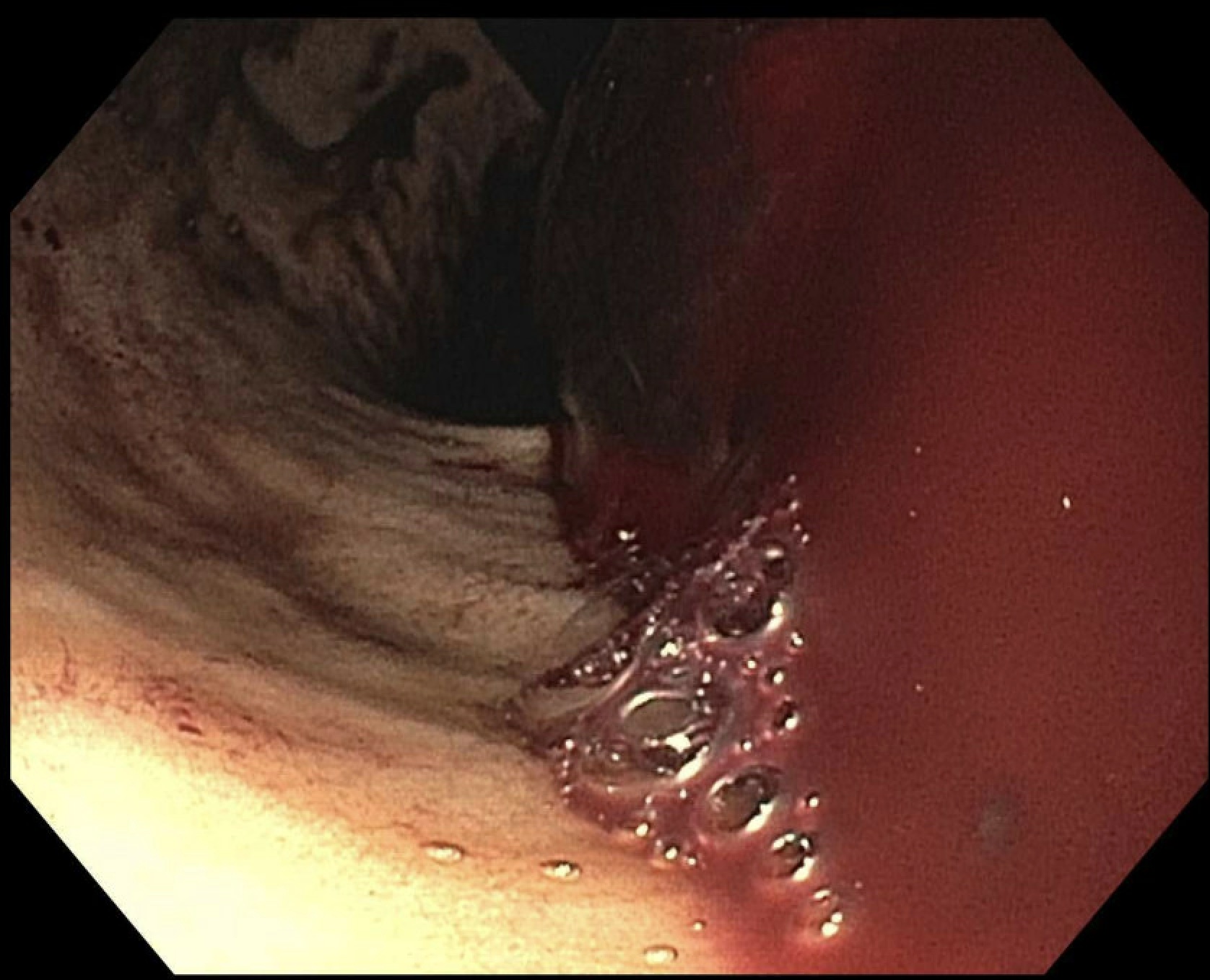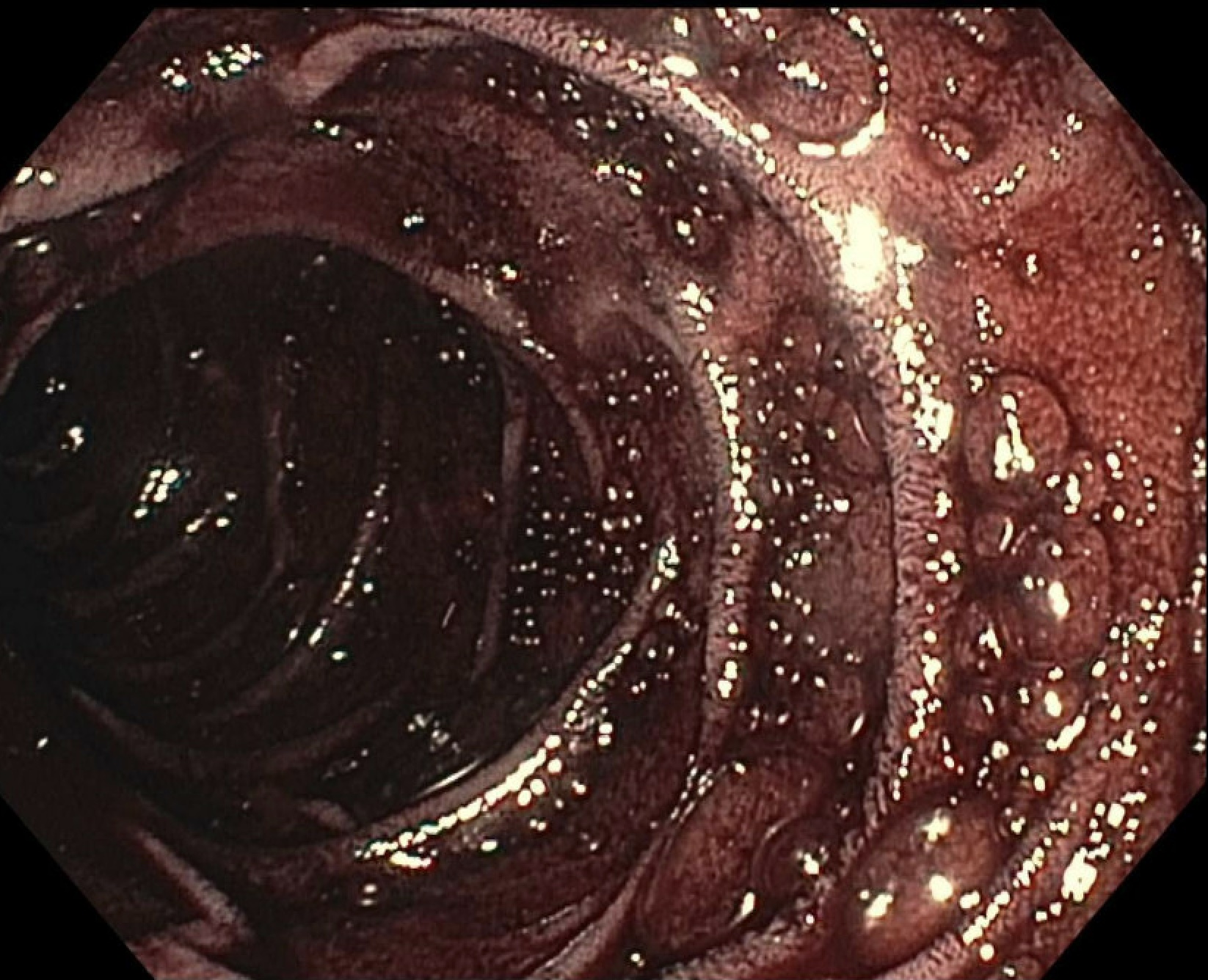Monday Poster Session
Category: Biliary/Pancreas
P2333 - Massive Gastrointestinal Hemorrhage as an Initial Presentation of Invasive Pancreatic Cancer
Monday, October 27, 2025
10:30 AM - 4:00 PM PDT
Location: Exhibit Hall
- EC
Ellen Choi, DO
Englewood Hospital and Medical Center
Englewood, NJ
Presenting Author(s)
Ellen Choi, DO, Ayman Elnail, MD, Vivienne Qie, MD, Tanganyika Barnes, DO
Englewood Hospital and Medical Center, Englewood, NJ
Introduction: Pancreatic cancer is an uncommon cause of gastrointestinal hemorrhage. Pancreatic carcinoma can directly invade the stomach and lead to acute gastrointestinal bleeding. However, the reported incidence remains very low. We present a rare case in which a patient’s initial symptoms of invasive pancreatic cancer were hematemesis and hematochezia.
Case Description/
Methods: A 54-year-old female with a past medical history of hypertension presented to the emergency department with two episodes of vomiting bright red blood and two bloody bowel movements. The patient reported using ibuprofen over the past two weeks during a viral illness. She was hypotensive and tachycardic. Laboratory results showed a hemoglobin of 9.9 g/dL, a significant drop from her baseline.
The patient was started on a proton pump inhibitor drip and underwent an urgent esophagogastroduodenoscopy (EGD). It showed massive gastrointestinal bleeding with fresh blood and clots in the esophagus, stomach, and duodenum. She received blood transfusions and vasopressor support. Computed tomography angiography revealed active extravasation of contrast from the distal splenic artery into a pancreatic tail mass lesion, eroding into the posterior wall of the stomach and resulting in a large intragastric hematoma.
The patient underwent splenic pseudoaneurysm embolization and was further stabilized with four units of packed red blood cells and one unit of cryoprecipitate. A repeat EGD revealed a perforation and necrotic area at the gastric cardia where a pancreatic mass had eroded into the stomach wall. Immunohistochemical analysis of biopsy samples was consistent with primary pancreatic adenocarcinoma.
Discussion: Pancreatic tumors typically present with nonspecific symptoms such as weight loss, jaundice, or abdominal pain. However, our patient’s initial presentation involved massive gastrointestinal bleeding from a pancreatic tail mass eroding into the gastric cardia which is not a common site of involvement. A splenic artery pseudoaneurysm can rarely rupture as a complication of pancreatic tail tumors, given their proximity to the splenic vessels. While the patient’s NSAID use may have contributed to mucosal injury, the extent of bleeding was severe enough to consider a broader differential diagnosis including structural causes. This case also highlights the aggressive nature of pancreatic cancer and the life-threatening vascular complications that can result from its direct invasion.

Figure: EGD demonstrating extensive active bleeding with a massive accumulation of fresh blood in the gastric fundus.

Figure: EGD showing fresh blood and clot formation in the second part of the duodenum.
Disclosures:
Ellen Choi indicated no relevant financial relationships.
Ayman Elnail indicated no relevant financial relationships.
Vivienne Qie indicated no relevant financial relationships.
Tanganyika Barnes indicated no relevant financial relationships.
Ellen Choi, DO, Ayman Elnail, MD, Vivienne Qie, MD, Tanganyika Barnes, DO. P2333 - Massive Gastrointestinal Hemorrhage as an Initial Presentation of Invasive Pancreatic Cancer, ACG 2025 Annual Scientific Meeting Abstracts. Phoenix, AZ: American College of Gastroenterology.
Englewood Hospital and Medical Center, Englewood, NJ
Introduction: Pancreatic cancer is an uncommon cause of gastrointestinal hemorrhage. Pancreatic carcinoma can directly invade the stomach and lead to acute gastrointestinal bleeding. However, the reported incidence remains very low. We present a rare case in which a patient’s initial symptoms of invasive pancreatic cancer were hematemesis and hematochezia.
Case Description/
Methods: A 54-year-old female with a past medical history of hypertension presented to the emergency department with two episodes of vomiting bright red blood and two bloody bowel movements. The patient reported using ibuprofen over the past two weeks during a viral illness. She was hypotensive and tachycardic. Laboratory results showed a hemoglobin of 9.9 g/dL, a significant drop from her baseline.
The patient was started on a proton pump inhibitor drip and underwent an urgent esophagogastroduodenoscopy (EGD). It showed massive gastrointestinal bleeding with fresh blood and clots in the esophagus, stomach, and duodenum. She received blood transfusions and vasopressor support. Computed tomography angiography revealed active extravasation of contrast from the distal splenic artery into a pancreatic tail mass lesion, eroding into the posterior wall of the stomach and resulting in a large intragastric hematoma.
The patient underwent splenic pseudoaneurysm embolization and was further stabilized with four units of packed red blood cells and one unit of cryoprecipitate. A repeat EGD revealed a perforation and necrotic area at the gastric cardia where a pancreatic mass had eroded into the stomach wall. Immunohistochemical analysis of biopsy samples was consistent with primary pancreatic adenocarcinoma.
Discussion: Pancreatic tumors typically present with nonspecific symptoms such as weight loss, jaundice, or abdominal pain. However, our patient’s initial presentation involved massive gastrointestinal bleeding from a pancreatic tail mass eroding into the gastric cardia which is not a common site of involvement. A splenic artery pseudoaneurysm can rarely rupture as a complication of pancreatic tail tumors, given their proximity to the splenic vessels. While the patient’s NSAID use may have contributed to mucosal injury, the extent of bleeding was severe enough to consider a broader differential diagnosis including structural causes. This case also highlights the aggressive nature of pancreatic cancer and the life-threatening vascular complications that can result from its direct invasion.

Figure: EGD demonstrating extensive active bleeding with a massive accumulation of fresh blood in the gastric fundus.

Figure: EGD showing fresh blood and clot formation in the second part of the duodenum.
Disclosures:
Ellen Choi indicated no relevant financial relationships.
Ayman Elnail indicated no relevant financial relationships.
Vivienne Qie indicated no relevant financial relationships.
Tanganyika Barnes indicated no relevant financial relationships.
Ellen Choi, DO, Ayman Elnail, MD, Vivienne Qie, MD, Tanganyika Barnes, DO. P2333 - Massive Gastrointestinal Hemorrhage as an Initial Presentation of Invasive Pancreatic Cancer, ACG 2025 Annual Scientific Meeting Abstracts. Phoenix, AZ: American College of Gastroenterology.
